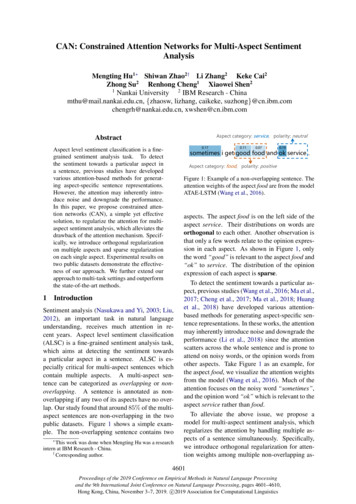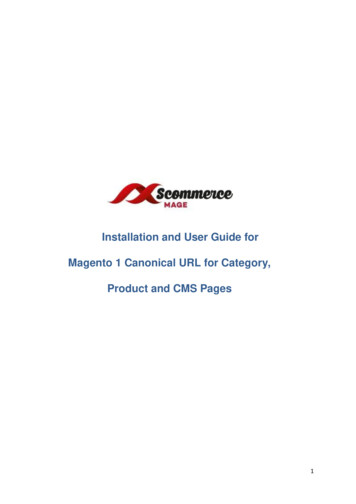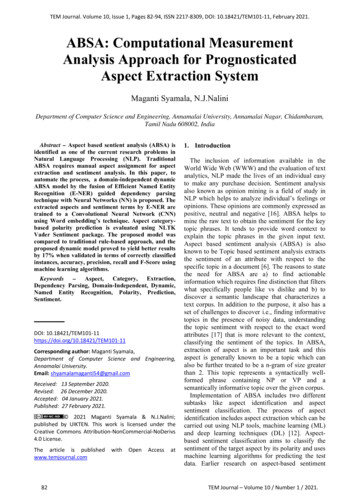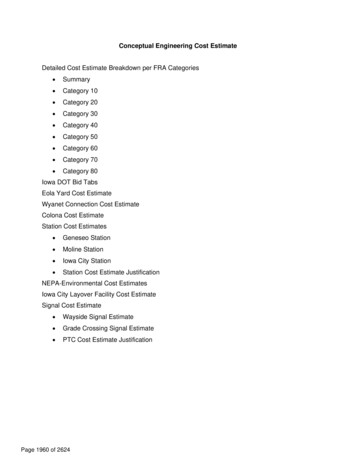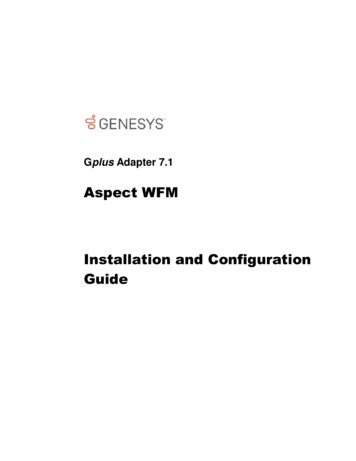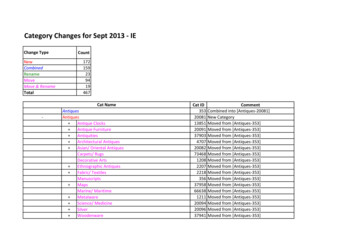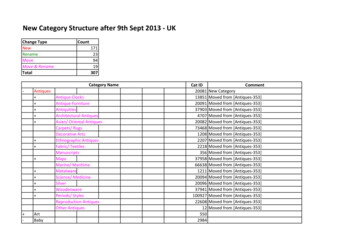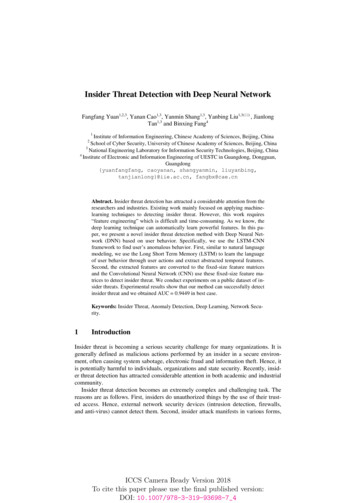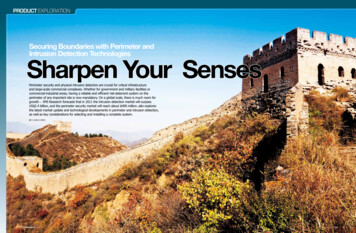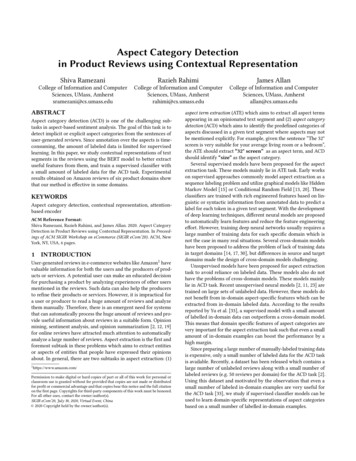
Transcription
Aspect Category Detectionin Product Reviews using Contextual RepresentationShiva RamezaniRazieh RahimiJames AllanCollege of Information and ComputerSciences, UMass, Amherstsramezani@cs.umass.eduCollege of Information and ComputerSciences, UMass, Amherstrahimi@cs.umass.eduCollege of Information and ComputerSciences, UMass, Amherstallan@cs.umass.eduABSTRACTAspect category detection (ACD) is one of the challenging subtasks in aspect-based sentiment analysis. The goal of this task is todetect implicit or explicit aspect categories from the sentences ofuser-generated reviews. Since annotation over the aspects is timeconsuming, the amount of labeled data is limited for supervisedlearning. In this paper, we study contextual representations of textsegments in the reviews using the BERT model to better extractuseful features from them, and train a supervised classifier witha small amount of labeled data for the ACD task. Experimentalresults obtained on Amazon reviews of six product domains showthat our method is effective in some domains.KEYWORDSAspect category detection, contextual representation, attentionbased encoderACM Reference Format:Shiva Ramezani, Razieh Rahimi, and James Allan. 2020. Aspect CategoryDetection in Product Reviews using Contextual Representation. In Proceedings of ACM SIGIR Workshop on eCommerce (SIGIR eCom’20). ACM, NewYork, NY, USA, 6 pages.1INTRODUCTIONUser-generated reviews in e-commerce websites like Amazon1 havevaluable information for both the users and the producers of products or services. A potential user can make an educated decisionfor purchasing a product by analyzing experiences of other usersmentioned in the reviews. Such data can also help the producersto refine their products or services. However, it is impractical fora user or producer to read a huge amount of reviews and analyzethem manually. Therefore, there is an emergent need for systemsthat can automatically process the huge amount of reviews and provide useful information about reviews in a suitable form. Opinionmining, sentiment analysis, and opinion summarization [2, 12, 19]for online reviews have attracted much attention to automaticallyanalyze a large number of reviews. Aspect extraction is the first andforemost subtask in these problems which aims to extract entitiesor aspects of entities that people have expressed their opinionsabout. In general, there are two subtasks in aspect extraction: (1)1 https://www.amazon.com/Permission to make digital or hard copies of part or all of this work for personal orclassroom use is granted without fee provided that copies are not made or distributedfor profit or commercial advantage and that copies bear this notice and the full citationon the first page. Copyrights for third-party components of this work must be honored.For all other uses, contact the owner/author(s).SIGIR eCom’20, July 30, 2020, Virtual Event, China 2020 Copyright held by the owner/author(s).aspect term extraction (ATE) which aims to extract all aspect termsappearing in an opinionated text segment and (2) aspect categorydetection (ACD) which aims to identify the predefined categories ofaspects discussed in a given text segment where aspects may notbe mentioned explicitly. For example, given the sentence “The 32"screen is very suitable for your average living room or a bedroom”,the ATE should extract “32" screen” as an aspect term, and ACDshould identify “size” as the aspect category.Several supervised models have been proposed for the aspectextraction task. These models mainly lie in ATE task. Early workson supervised approaches commonly model aspect extraction as asequence labeling problem and utilize graphical models like HiddenMarkov Model [15] or Conditional Random Field [13, 20]. Theseclassifiers are trained with rich engineered features based on linguistic or syntactic information from annotated data to predict alabel for each token in a given text segment. With the developmentof deep learning techniques, different neural models are proposedto automatically learn features and reduce the feature engineeringeffort. However, training deep neural networks usually requires alarge number of training data for each specific domain which isnot the case in many real situations. Several cross-domain modelshave been proposed to address the problem of lack of training datain target domains [14, 17, 30], but differences in source and targetdomains made the design of cross-domain models challenging.Unsupervised models have been proposed for aspect extractiontask to avoid reliance on labeled data. These models also do nothave the problems of cross-domain models. These models mainlylie in ACD task. Recent unsupervised neural models [2, 11, 23] aretrained on large sets of unlabeled data. However, these models donot benefit from in-domain aspect-specific features which can beextracted from in-domain labeled data. According to the resultsreported by Yu et al. [33], a supervised model with a small amountof labelled in-domain data can outperform a cross-domain model.This means that domain specific features of aspect categories arevery important for the aspect extraction task such that even a smallamount of in-domain examples can boost the performance by ahigh margin.Since preparing a large number of manually-labeled training datais expensive, only a small number of labeled data for the ACD taskis available. Recently, a dataset has been released which contains alarge number of unlabeled reviews along with a small number oflabeled reviews (e.g. 50 reviews per domain) for the ACD task [2].Using this dataset and motivated by the observation that even asmall number of labeled in-domain examples are very useful forthe ACD task [33], we study if supervised classifier models can beused to learn domain-specific representations of aspect categoriesbased on a small number of labelled in-domain examples.
SIGIR eCom’20, July 30, 2020, Virtual Event, ChinaOne important part of text classification models is input representation, where useful features can be extracted from input todetect the text label [18]. Current ACD models only consider a textsegment of a review as the input of the classifier. However, weobserved that some text segments do not have enough informationto extract useful features from. Indeed, the text segment in a reviewmay be dependent on the other parts of the review and thus doesnot have enough information by itself for detection of aspects. Forexample, consider this review from the TV domain: “There were alot of menus and setups involved when we first got it. That was alittle daunting.” In this example, there are two sentences that bothof them are talking about the feature category “ ease of use” in theTV domain. However, the second sentence itself cannot give thisinformation and we need the first sentence to fully understand thesecond one. To tackle this issue, we propose an in-review contextualrepresentation of text segments to better extract useful featuresfrom a given text segment. In our model, we feed the entire reviewas input and try to generate a representation of a text segment byattending to the entire review.The rest of the paper is organized as follows. We provide relatedwork on aspect extraction in Section 2. In Section 3, we definethe problem and in section 4, we present our proposed model indetails. Then we describe experimental settings in section 5 andempirically validate our hypotheses in section 6. Finally, we talkabout the future work and conclude the paper in section 7.2RELATED WORKAspect extraction has gained more attention by emerging of the pioneer work of [12]. In this paper, authors hypothesize that noun andnoun phrases of each sentence are most likely to be product features.At the first step, they use part-of-speech tagging techniques to findnoun/noun phrases as candidate aspect of item in the review. Then,they use some predefined rules to find frequent features and usefeature pruning techniques to remove redundant or uninterestingfeatures. Following this pioneer work, many rule-based models hasbeen designed using frequency co-occurrence or syntactic structureof the sentence [22, 26, 35]. These models need feature engineeringto define useful rules and are heavily depend on quality of textparser that constructs the dependency tree. In addition to that, usergenerated reviews are not always precise enough to be parsed witha text parser and it cause inaccurate dependency tree.Supervised models mainly consider this task as sequence labelingand try to assign label to each token of given text sentence. Theseworks employ recurrent neural networks [21], use dependencybased embeddings as features in a Conditional Random Field [32],or combine a recursive neural network with CRFs to jointly modelaspect and sentiment terms [31]. Considering the fact that opinionand aspect in a text segment are highly correlated, many multi taskmodels have been proposed to use syntactic relation between themto simultaneously extract opinion and aspects [19, 28]. However,the gold data is not always available for this joint learning, anddependency parsers are not always accurate enough to extract therelation between opinion terms and aspect terms. Recently, [17]designed a multi-task cross domain model by proposing a multihop Dual Memory Interaction (DMI) mechanism to automaticallyShiva Ramezani, Razieh Rahimi, and James Allancapture the latent relations among aspect and opinion words andget rid of need for linguistic resources.To deal with the problem of training data , researchers tried todesign cross domain models [8, 17, 29, 30] to transfer sentimentknowledge from source domain to a target domain that doesn’thave any in-domain labelled training data. But some other problemin this setting makes cross domain models challenging for this task:1) Different aspect spaces. Although some domains have commonaspect categories like price and size, each domain has its own specific aspect categories. For example battery life is an aspect categoryfor laptop but not a valid aspect for laptop cover. 2) Different termusage. different domains can have different terms for same aspectcategory. For example for aspect category “siz”, terms like XL andL are used in clothing domain while numbers are used in shoesdomain. 3)Different meaning. Some words have different meaningin different domains. For example the word memory is related to thefeature storage in Laptop domain while it has a different meaningin Mattress domain.Unsupervised models in the other hand, doesn’t have these problems. These approaches have been started by LDA based topic models [4, 6, 24, 34] that try to provide word distributions or rankingsfor each aspect category. Zhao et. al. [34] proposed MaxEnt-LDA tojointly extract aspect and opinion words. Chen et. al. [6] proposedto discover aspects by automatically learning prior knowledge froma large amount of online data. Wang et. al. [27] proposed a modifiedrestricted Boltzmann machine (RBM), which jointly learn aspectsand sentiment of text by using prior knowledge. Recently, unsupervised neural model attempted to learn aspect representatives fromunlabeled corpus by reconstructing the input sentence. An unsupervised neural model named Aspect Based Auto Encoder (ABAE) [11]proposed an autoencoder model based on attention mechanismto train a latent representation that indicates probability distribution of input text segment over different aspect categories. Theautoencoder part of this model attempts to reconstruct the inputsegment’s encoding as a linear combination of aspect embeddingswhere aspect embeddings are learned by minimizing the segmentreconstruction error. Then a weakly supervised extension of ABAEmodel named Multi-seed Aspect Extractor (MATE ) [2] has beenproposed that utilizes small amount of labelled data to extract seedwords for each aspect category, and utilizes weighted sum of theseseed words for each aspect category to create embedding of that aspect. This model then initializes aspect matrix of ABAE model withthese values and fix them during training. Aspect Extraction withSememe Attentions [23] is a hierarchical model similar to ABAEthat in addition to word vectors and aspect vectors, this model alsoconsiders sense and sememe [5] vectors in computing the attentiondistribution.3PROBLEM DEFINITIONAspect Category Detection is a classification task where a textsegment in a review should be classified according to a subsetof predefined aspect labels. For each product domain 𝑑, e.g., keyboards or vacuums, we have a corpus containing set of reviews𝑅𝑑 {𝑟𝑒 1, . . . , 𝑟𝑒𝑛 } where each review is split into text segments(𝑠 1, 𝑠 2, ., 𝑠𝑘 ). A text segment in the ACD task can be a sentence,phrase or Elementary Discourse Unit (EDU) [9] which corresponds
Aspect Category Detectionin Product Reviews using Contextual Representationto a clause-level text segment. In our setting we are using EDU astext segment since in our dataset, aspect labels are available in EDUlevel [2]. The reason they are preferred is that EDU level segmentation have been shown to facilitate other related tasks like summarization, single document opinion extraction and document levelsentiment analysis [1, 3, 16]. The ACD aims to classify a text segment 𝑠 {𝑤 1, ., 𝑤𝑧 } into an aspect category 𝑦 A𝑑 {𝑦1, ., 𝑦𝑚 }where A𝑑 is set of predefined aspect categories in domain 𝑑. EachA𝑑 contains a general aspect which is assigned to segments thatdo not discuss any specific aspects.4SIGIR eCom’20, July 30, 2020, Virtual Event, Chinaword in the target text segment by paying attention to the otherparts of the review. Figure 2 shows the representation layer of theproposed model. The input text to this layer is built by adding a[CLS] token at the beginning and a [SEP] token at the end of eachtext segment in a review. To discriminate the target text segmentfrom others, we also add specific tokens to the beginning and endof the target text segment in addition to [CLS] and [SEP] tokens.Then we consider the average of token representations in the targettext segment as its representation. This manner, the target textsegment will have a representation that is aware of other relatedparts in the review.METHODOLOGYWe hypothesize that the representation of each text segment iscorrelated with other text segments in a review. Considering thishypothesis, we propose a supervised model that can benefit froma better representation built by using the entire review. Figure 1shows the architecture of our model. The network consists of twomain components: 1) a representation layer containing a BERT component that tries to transform a given text segment to a rich vectorrepresentation, and 2) a multi-layer perceptron (MLP) classifier thattakes the vector representation and returns probability distributionof aspect categories.4.2Classification LayerThe classifier aims to estimate a distribution of aspect probability𝑞(𝑦 𝑟𝑠 ), where 𝑟𝑠 is a feature representation of a text segment provided by the representation layer and 𝑦 is a vector with a size ofnumber of aspect categories. We use a simple Softmax classifier ontop of two layer feed forward neural network for this layer. Thegoal of this layer is to capture aspect related features of the textsegment and represent it as a probability distribution over aspectcategories.5 EXPERIMENTAL SETTING5.1 DatasetWe use the OpoSum dataset [2] for training and evaluating of ourmodel. This dataset contains reviews from 6 product domains fromAmazon: Laptop Bags, Bluetooth Headsets, Boots, Keyboards, Televisions, and Vacuums. Reviews are down sampled from the AmazonProduct Dataset [10] and are segmented into Elementary DiscourseUnits (EDUs [9]). For each product domain, the OpoSum datasetcontains 100 reviews from 10 different products with around 1000EDU-level aspect annotations that are equally divided to the development and test sets (50 reviews and 500 EDUs in each set). We usethe development set for training and the test set for evaluation.For pre-processing the dataset, we follow the experimental settings of previous work [2, 11] to make our results comparable to thepreviously reported results. The dataset is pre-processed by lemmatization, removing punctuation symbols, and removing EDUs withless than two words. Multi-labelled sentences are also removed toavoid ambiguity. Table 1 shows the statistics of pre-processed datafor each product domain.Figure 1: Architecture of our model5.24.1Representation LayerThe representation layer transforms raw text to a fixed-size vectorrepresentation encoding useful information of the input text. Weuse BERT, a strong feature extraction model for this layer. However,if the input text segment does not have enough information, wecannot extract useful information even with a good feature extraction model. Since EDU segments are clause level discourse and areroughly short, they may not have enough information by themselves. Thus, having the entire review as input can help to betterrepresent a given text segment. To do so, we feed the entire reviewto the representation layer and update the representation of eachEvaluation MetricTo evaluate and compare different models, we use macro-F1 score.We calculate the F1 score of each aspect category and then averagethem to calculate the macro-F1 score of a given domain. We alsocalculate micro-F1 score of baselines to compare them with previousstate-of-the art models since their result is reported in micro-F1score.5.3BaselinesIn order to show the effectiveness of our proposed representation,we compare it with multiple baselines for each product domain.For the baselines, the inputs are target text segments without theknowledge of other text segments in the review, while for our
SIGIR eCom’20, July 30, 2020, Virtual Event, ChinaShiva Ramezani, Razieh Rahimi, and James AllanFigure 2: Representation layerTable 1: The number of EDU segments in each set of the dataset.DomainLaptop BagsBluetooth HeadsetsBootsKeyboardsTelevisionsVacuumsUnlabelled datasetTraining setTest 9670687613637578667701687proposed model the input is the entire review. We also compare ourbaselines with state-of-the-art unsupervised and weak supervisedmodels to study if a supervised model trained only on a smallnumber of labelled in-domain data can outperform unsupervisedor weakly supervised models trained on large unlabeled in-domaindata. The baseline methods are as follows:5.3.1 𝐴𝐵𝐴𝐸𝑖𝑛𝑖𝑡 [11]. This baseline is an unsupervised neural network approach that uses Neural Bag of Words (NBOW) as sentencerepresentation and learns aspect embeddings in a reconstructionprocess, where an attention mechanism is used to filter non-aspectwords. This model contains an aspect embedding matrix which willbe trained on a large amount of unlabeled data.5.3.2 𝑀𝐴𝑇 𝐸 𝑀𝑇 [2]. This model is a weakly supervised autoencoder extension of the ABAE model that initializes the aspectembedding matrix using seed words for each aspect category andfix them during training. These seed words are extracted from asmall amount of in-domain labeled data.5.3.3 𝐴𝑣𝑔. This is a baseline neural model for text classificationtask that considers the average of embedding of words in a textsegment as its representation. For word embeddings, we use embeddings trained on large unlabeled in-domain data.5.3.4 𝐴𝑡𝑡𝑒𝑛𝑡𝑖𝑜𝑛. In this model, we utilize embeddings of aspectcategories to generate different aspect-dependent representations ofthe given text segment by attending to the embedding of each aspectcategory, and then use concatenation of these aspect-dependentrepresentations as the representation of the text segment. Figure 3shows the architecture of this model in detail. The first step in thismodel is generating the embedding matrix of aspect categories.To do so, we follow the approach proposed by Angelidis and Lapata (2018b) to obtain a ranked list of terms and their scores using avariant of a clarity scoring function [7] which measures the probability of observing word 𝑤 in the subset of segments that discussaspect 𝑎. The weighted sum of embeddings of the top ranked words(e.g. top 30 words) for each aspect category is considered as the embedding representation of the aspect category. In the next step, wecompute different representations of a text segment by attendingto each aspect category and provide aspect-dependent representations. For each aspect category, we calculate aspect-dependentrepresentations of the text segment by computing the weightedsum of word embeddings in the text segment. The weights arecosine similarities between the embedding of the current word andword embeddings of the aspect. We then concatenate these aspectdependent representations and feed them to a MLP to classify theinput text segment.
Aspect Category Detectionin Product Reviews using Contextual RepresentationSIGIR eCom’20, July 30, 2020, Virtual Event, Chinain the text classification. BERT language model which is pretrainedon large amount of data can be transferred to a new task by smallamount of task-specific labeled data and can provide a better textrepresentation. At the end, the result shows that our model is performing better than other models on average. The performance ofour model is the second best performance in some domains. Thisshows that there are some text segments that their representationis dependent on the other parts of the review. However, we cansee the performance decreases in Boots and Vacuums domains incomparison to the BERT-CLS model which might show that ourproposed representation can also add noise in some cases.7Figure 3: Architecture of attention model5.3.5 𝐵𝐸𝑅𝑇 𝐶𝐿𝑆. In this baseline model, a text segment is fed tothe base-uncased BERT model and the representation of the [CLS]token is considered as the representation of input. We then feed thisrepresentation to the classifier layer to classify the text segment.Indeed, this model is a base model in BERT model for sentenceclassification. We consider this baseline to study if other parts ofthe review that used in our model are useful to categorize a giventext segment.5.4Model ConfigurationFor each product domain, we fine-tune the hyperparameters on20% of training data and then train the model on the rest of trainingdata for 300 epochs. Test data is used for evaluation. In the classifier,number of neurons of feed forward layer is 64. We use learningrate of 1e-4 and batch size of 16 for training the models. We use300-dimensional word embeddings pre-trained on unlabeled dataof each product domain using skip-gram [25], and fix it duringtraining phase of the classifier model. Out of vocabulary wordsare replaced by the unknown (UNK) token. For aspect embeddingmatrix, used in MATE MT and attention model, we use the top 30seeds of each aspect category and calculate the weighted sum ofseed words as the aspect embedding.6RESULTSTable 2 shows the results of the state-of-the art unsupervised andweakly supervised models trained on large unlabeled data, supervised models trained on small labeled data, and our proposed modeltrained on small labeled data. Bold numbers are the best performance and underlined numbers are the second best performance.First of all we can observe that result of worst supervised modelis better than performance of state-of-the-art unsupervised andweakly supervised models. This shows that supervised modelstrained only on a small amount of labeled data can perform muchbetter, and in-domain aspect-specific features are very important inthis task. By comparing the results of the Avg model and Attentionmodel, we can realize that information about aspect categories canboost the performance by a high margin. The results in the tablealso show that the best baseline is the BERT-CLS model whichshows feature extraction from text segments is an important partCONCLUSION AND FUTURE WORKAspect category detection is a crucial sub-task in fine-grained sentiment analysis and related problems. Since providing a large labeledtraining data to train deep learning models for this task is expensive, very small number of product domains have labelled data forthis task. Researchers proposed several cross domain and unsupervised models to tackle this problem, however considering thefact that each product domain has its own specific features andlanguage, designing a cross-domain model is challenging for thistask. On the other hand, unsupervised models cannot learn semantic features of the domain very well. One important part in textclassification tasks is providing a rich and useful representation ofthe text. According to our observation, some text segments do nothave enough information by themselves, and their meanings arehighly correlated with other parts of their reviews. Consideringthis observation, we proposed a new contextual in-review representation in which a segment representation is generated by attendingto other parts of the review and can be enriched by informativeparts of the review. Experimental results show that our model canslightly improve the performance. In addition, we observed thatnot only representations of two nearby segments, but also theiraspect categories are correlated. In the future, we would like todesign a semi supervised model that can use large unlabeled datato learn language-specific features of each domain and use smallin-domain labeled data to extract aspect-dependent semantic features of the domain. We are also interested in developing modelsfor joint aspect-category prediction of nearby text segments in areview following our observations in this study.ACKNOWLEDGEMENTThis work was supported in part by the Center for Intelligent Information Retrieval and in part by NSF grant #1813662. Any opinions,findings and conclusions or recommendations expressed in thismaterial are those of the authors and do not necessarily reflectthose of the sponsor.REFERENCES[1] Stefanos Angelidis and Mirella Lapata. 2018. Multiple instance learning networks for fine-grained sentiment analysis. Transactions of the Association forComputational Linguistics 6 (2018), 17–31.[2] Stefanos Angelidis and Mirella Lapata. 2018. Summarizing Opinions: AspectExtraction Meets Sentiment Prediction and They Are Both Weakly Supervised.In Proceedings of the 2018 Conference on Empirical Methods in Natural LanguageProcessing. 3675–3686.[3] Parminder Bhatia, Yangfeng Ji, and Jacob Eisenstein. 2015. Better document-levelsentiment analysis from rst discourse parsing. arXiv preprint arXiv:1509.01599(2015).
SIGIR eCom’20, July 30, 2020, Virtual Event, ChinaShiva Ramezani, Razieh Rahimi, and James AllanTable 2: Comparison of different models. The numbers in the upper part are micro-f1 and the numbers in the lower part aremacro-f1.ModelLaptop umsAVGABAE initMATE 61.162.268.5AvgAttentionBERT-CLSNewBERT .248.550.255.556.5[4] David M Blei, Andrew Y Ng, and Michael I Jordan. 2003. Latent dirichlet allocation.Journal of machine Learning research 3, Jan (2003), 993–1022.[5] Leonard Bloomfield. 1926. A set of postulates for the science of language. Language 2, 3 (1926), 153–164.[6] Zhiyuan Chen, Arjun Mukherjee, and Bing Liu. 2014. Aspect extraction withautomated prior knowledge learning. In Proceedings of the 52nd Annual Meetingof the Association for Computational Linguistics (Volume 1: Long Papers). 347–358.[7] Steve Cronen-Townsend, Yun Zhou, and W Bruce Croft. 2002. Predicting queryperformance. In Proceedings of the 25th annual international ACM SIGIR conferenceon Research and development in information retrieval. 299–306.[8] Ying Ding, Jianfei Yu, and Jing Jiang. 2017. Recurrent neural networks withauxiliary labels for cross-domain opinion target extraction. In Thirty-First AAAIConference on Artificial Intelligence.[9] Vanessa Wei Feng and Graeme Hirst. 2012. Text-level discourse parsing with richlinguistic features. In Proceedings of the 50th Annual Meeting of the Associationfor Computational Linguistics (Volume 1: Long Papers). 60–68.[10] F Maxwell Harper and Joseph A Konstan. 2015. The movielens datasets: Historyand context. Acm transactions on interactive intelligent systems (tiis) 5, 4 (2015),1–19.[11] Ruidan He, Wee Sun Lee, Hwee Tou Ng, and Daniel Dahlmeier. 2017. An unsupervised neural attention model for aspect extraction. In Proceedings of the 55thAnnual Meeting of the Association for Computational Linguistics (Volume 1: LongPapers). 388–397.[12] Minqing Hu and Bing Liu. 2004. Mining and summarizing customer reviews.In Proceedings of the tenth ACM SIGKDD international conference on Knowledgediscovery and data mining. 168–177.[13] Niklas Jakob and Iryna Gurevych. 2010. Extracting opinion targets in a single-andcross-domain setting with conditional random fields. In Proceedings of the 2010conference on empirical methods in natural language processing. Association forComputational Linguistics, 1035–1045.[14] Zhuoren Jiang, Zheng Gao, Jinjiong Lan, Hongxia Yang, Yao Lu, and XiaozhongLiu. 2020. Task-Oriented Genetic Activation for Large-Scale Complex Heterogeneous Graph Embedding. In Proceedings of The Web Conference 2020. 1581–1591.[15] Wei Jin and Hung Hay Ho. 2009. A novel lexicalized HMM-based learningframework for web opinion mining. In Proceedings of the 26th Annual InternationalConference on Machine Learning. ACM, 465–472.[16] Junyi Jessy Li, Kapil Thadani, and Amanda Stent. 2016. The role of discourseunits in near-extractive summarization. In Proceedings of the 17th Annual Meetingof the Special Interest Group on Discourse and Dialogue. 137–147.[17] Zheng Li, Xin Li, Ying Wei, Lidong Bing, Yu Zhang, and Qiang Yang. 2019. Transferable end-to-end aspect-based sentiment analysis with se
Aspect category detection (ACD) is one of the challenging sub-tasks in aspect-based sentiment analysis. The goal of this task is to detect implicit or explicit aspect categories from the sentences of user-generated reviews. Since annotation over the aspects is time-consuming, the amount of labeled data is limited for supervised learning.
